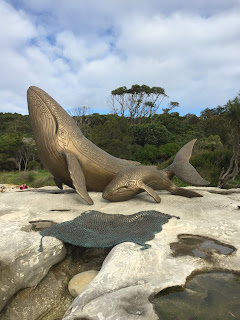We could finally take a little drive into Sydney's central business district without feeling like we were cheating fate! As things have opened up more, there are more people about, but everyone seems to be cautious and trying to keep their distance. Then we walked by one of the large pedestrian malls and that wasn't quite as true. Such strange times when even a little head cold makes one worry it's something more serious. We loved walking back around the Circular Quay area and seeing the iconic sights that we encountered on our first visit: the Sydney Opera House, the Sydney Harbour Bridge often called the Coathanger, and the Sydney Tower. Now we feel like we are really back in Australia!
We were interested to see the Sydney Fish Market since we'd heard it was open. We were expecting something like Seattle's beloved Pike Street Market but there were no flying fish here. A number of fish markets in one building with abundant choices of seafood with just a couple of takeaway restaurants and very limited seating. But the pelicans knew where to get something and were so tame we walked right by them. I'm certain the lobster here would out rank those in the tank at our local Red Lobster.
Wanting to see Paddy's Market, a well-known market area in the Haymarket area, we drove there and began walking all around Sydney. First, we found the market was still closed and will open again next week. So we will go back on another day. But we enjoyed our time in the city anyway. Walking past an entrance to the China Town area, we headed toward Hyde Park. We were a bit caught off-guard to find Sydney's German Lutheran church (Kirche). We felt right at home!
The ANZAC memorial was impressive with beautiful cascading fountains and reflecting pools. On to Hyde Park and another Statue of James Cook.
St. Mary's Cathedral is the seat of the Archbishop of Sydney and the Roman Catholic Church in Sydney. It is an example of 19th century Gothic construction. We hope to see inside when it is opened again to the public.
Hyde Park was the first public land set aside in Australia for parkland. Yes, it was named after the other Hyde Park in London. Beautiful grounds, gardens and walkways with various fountains were still beautiful to see even as winter is settling in here in the southern hemisphere. Such a beautiful day with the temperature near 70, I could have winter like this forever.
This is a statue of Major General Lachlan Macquarie who was an early governor of Australia. We have him to thank for having to drive on the left side of the road. Many places here are named in his honor such as streets, parks, islands, rivers, and even a university. I'm not so certain everyone likes his "Father of Australia" designation especially those of aboriginal descent whose ancestors were met with hostile actions if they didn't conform to his wishes.
We continued our walk past the Hyde Park Barracks where originally Governor Macquarie had built to house convict men and boys hoping to improve their behavior if lodging was provided for them. Now a museum which, yes, should open again soon we hope.
Another statue in the park of William Bede Dalley. He was an early politician and barrister ("Don, they put up memorials to attorneys here!") and the first Australian to serve on the Privy Council of the United Kingdom.
Known as The Mint, this was at first part of the early hospital. It was called "Rum Hospital" because Governor Macquarie is said to have paid for it with 45,000 gallons of rum! Later, it became the location of the first mint branch located outside of England. Now it is the headquarters of the Sydney Living Museums.
Near the Mint is the Sydney Hospital dating to 1788. It has been at this location since 1811. Many additions and upgrades through the years, but it is still in use and now specializes in ophthalmology and hand surgery. It is also a teaching hospital. A copy of Il Porcellino is outside the hospital. Like the original found in Florence, if a coin is dropped in the donation box and you then rub the pig's snout, you will receive good fortune.
Along the complex of historic buildings is Parliament House. This is the oldest public building in Sydney and unique since it once part of the first hospital.
Next door to Parliament House is the New South Wales State Library. We thought this banner was a good reminder of who tells the history and whose point of view is often forgotten. This week is also known as "Reconciliation Week" here in Australia. Not far from the banner is a statue of Matthew Flinders, an early explorer that circumnavigated and mapped the coastline of Australia. Behind him is a statue of his cat, Trim, which sailed with him on his voyages and even stayed with him when Flinders was imprisoned by the French.
The front of the New South Wales State Museum and fountain at the entrance of the Royal Botanic Gardens.
This is a statue of Arthur Phillip, the first governor of Australia. He established the first penal colony which later became the city of Sydney.
Some of the Royal Botanic Gardens and a view of Farm Cove.
The Government House which is the vice-regal residence of the Governor of New South Wales. Basically, the Queen's representative, not to be confused with the Premier of NSW who oversees the governing of New South Wales who is appointed by the viceregal!



















































